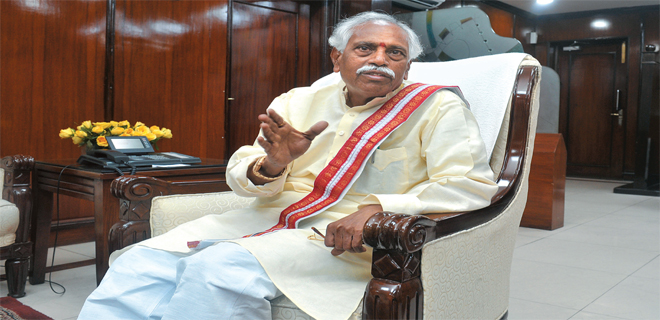We believe in competitive spirit: Bandaru Dattatreya
EPFO is still a tax-free instrument, says Bandaru Dattatreya, Minister of State for Labour and Employment

On account of its technology-enabled initiatives and ingrained scheme benefits, EPFO seems to be unfazed by the proposed flexibility for its subscribers to move to NPS. Bandaru Dattatreya, Minister of State for Labour and Employment speaks to Narayan Krishnamurthy and Prashant Kapoor. Excerpts:
The dynamics of the workforce have changed over the years. How well is EPFO geared up to service the growing needs of this dynamic workforce?
EPFO is rendering services to its subscribers since 1952. Presently, we have over 4.3 crore active members and we manage over 17 crore accounts. For the benefit of our members, we have been making effective use of the technology. For example, we are now using technology in account portability, account settlement and account updation. As of now, for 2014 and 2015, all the 17 crore accounts have been updated and presently all the claims are being settled within three days. Also, we are giving our subscribers the facility of getting the information regarding their account balances, pension amounts, etc., over the SMS, thereby relieving them from the inconvenience of visiting EPFO offices. Recently, we have also come out with an option for the EPF members wherein if they wish to defer their pension for two years after attaining the age of 58, then they’ll receive enhanced pension of additional 8.16 per cent of their original pension amount, or a 4 per cent increase for each.
There are talks of EPF subscribers to switch to NPS; what is the development on this front?
The EPF scheme is one of its kind and amongst the best in the world because under the EPF, subscribers receive pension benefits, disablement benefits, widow benefits, dependent benefits, etc. It is up to the subscribers to compare whether they will get similar benefits under NPS and the final judgment would be left in the hands of subscribers. However, for the subscribers who move to NPS, we’ll give them an option for them to come back to EPFO, if they want, after one year of their switch to NPS.
There is a difference between being part of the EPF and the NPS—the tax anomaly. There was a hint given by the government that this will be evened by taxing the EPF corpus. Is this likely to happen?
Currently, there is no proposal to tax any part of the EPF corpus of the subscribers at any stage and EPF would continue to remain a tax exempt investment option.
The move to allow the EPF corpus to invest in markets is welcome. Yet the unions are against it. Has the labour ministry thought of educating those against the move on the benefits of putting money in the markets?
Our paramount interest is to ensure the safety and security of the EPF corpus since it’s a hard-earned money of our subscribers. That’s why we’ll take a very cautious approach. The finance minister had already announced in the budget that 5 to 15 per cent of the corpus can be invested in the ETFs. World over, most of the EPF funds invest in the capital markets through the ETFs only. Initially there were lot of apprehensions from the trade unions regarding this move, and a presentation was also given by an independent consultancy, however, the apprehensions still continue.
Therefore, the ministry has taken a bold step and invested `7,000 crore. While the results were negative initially, the returns are now in the positive territory. So last year, while we had cautiously taken a decision decision to invest 5 per cent of the corpus in ETFs, the contribution for this year is still to be decided. Our Finance Audit and Investment Committee (FAIC) has recommended an equity allocation of 10 per cent in this fiscal. While we are creating awareness amongst workers, we believe that seeing the positive returns generated by investments in capital markets, the workers themselves will agree. We believe in transparency and accountability in the entire system.
What steps can be taken to make EPF the most preferred retirement option?
While we have discussed about some of our new initiatives earlier which are aimed at providing convenience to the EPF members, presently, we are also taking initiatives for furthering e-governance through mobile phones. In this direction, we had launched a mobile app on September 16, 2015. Further, we are consolidating all accounts through Universal Account Number (UAN) and Aadhar to ensure that there are no communication gaps. In addition, since 2015 we have started crediting interest in 9.23 crore inoperative accounts, thereby reversing the earlier decision taken under the UPA government in 2011 under which credit of interest was stopped in the inoperative accounts. We are very sensitive to the needs of the workers and understand it’s a competitive market, so it’s important to provide better services. We are also reducing the threshold to 10 workers for providing the EPFO coverage, from the earlier requirement of 20 workers in an establishment.
What initiatives are being taken under ESIC, for furthering the health and well-being of workers?
This is one of the top most areas for this government. In ESIC, we have started the second generation of reforms. In all ESIC hospitals, we have started the Swachh Bharat Abhiyan. There are two crore insured persons under ESIC and combined with their dependents we are servicing approximately eight crore people. We have introduced a facility wherein all laboratory and pathological records are available online and they don’t need to visit the ESIC hospitals for that. We have also started Ayush, i.e., Aayurveda, Yoga, Unani, Siddha and Homeopathy in all hospitals. Further, we have created separate hours for the treatment of senior citizens. Providing social security is one of the top priorities. Presently, the unorganised sector constitutes 93 per cent of our workforce or 40 crore people and is one of our focus areas. We are going to provide the ESIC and EPF facility to thm in a phased manner.
For the first time we have included all the construction workers, approximately 4.7 crore people, into the formal sector and they get all ESIC services. As a second step, we’ll be covering all rickshaw pullers and auto drivers. We have already started the pilot project in New Delhi and Hyderabad. In the third phase, we’ll be covering the Anganwadi workers, Asha workers and mid-day meal workers. In the last phase, we’ll be covering the domestic helps as well. Another important decision taken is to convert one-third of the 1,400 ESIC dispensaries into six-bed hospitals.We are also expanding ESIC services across the country and have started the facility in Manipur, Meghalaya, Mizoram and Andaman.









